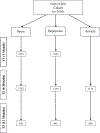Predictors of psychological distress in low-income mothers over the first postpartum year
- PMID: 30888077
- PMCID: PMC6472896
- DOI: 10.1002/nur.21943
Predictors of psychological distress in low-income mothers over the first postpartum year
Abstract
Up to 25% of postpartum women experience psychological distress including stress, depressive, or anxiety symptoms during the postpartum period. The purpose of this study was to explore the extent to which social determinants of health and allostatic load score, a 10-item index of biologic measures of chronic stress, predict psychological distress in low-income pregnant women over the first postpartum year. We conducted a secondary data analysis of the Child Community Health Research Network data set. The psychological distress outcome variables were perceived stress (n = 842), depression ( n = 845), and anxiety ( n = 846) symptoms, all measured categorically over the first year postpartum (T1:1 month, T2: 24-29 weeks, and T3: 50-65 weeks). Our predictors were social determinants of health (e.g., demographics, maternal hardship, percent poverty level, interpersonal violence, and food security) and allostatic load score. Generalized linear mixed models were used to determine which predictors were significantly associated with psychological distress symptoms across the first postpartum year. Interpersonal violence was a statistically significant risk factor for stress, depression, and anxiety symptoms over the first year postpartum. Other significant risk factors included low-income level, nativity, and perceived food security. Receiving food stamps was a significant protective factor for stress symptoms. The significance of risk factors for psychological distress, both modifiable and nonmodifiable, can be used as potential targets for further research, screening, and intervention. Future work should explore why and in what conditions these risk factors vary over time.
Keywords: allostatic load; anxiety; chronic stress; low-income mothers; postpartum depression; psychological distress; social determinants of health.
© 2019 Wiley Periodicals, Inc.
Conflict of interest statement
Similar articles
-
Influence of interpersonal violence on maternal anxiety, depression, stress and parenting morale in the early postpartum: a community based pregnancy cohort study.BMC Pregnancy Childbirth. 2012 Dec 15;12:153. doi: 10.1186/1471-2393-12-153. BMC Pregnancy Childbirth. 2012. PMID: 23241428 Free PMC article.
-
Mental health related determinants of parenting stress among urban mothers of young children--results from a birth-cohort study in Ghana and Côte d'Ivoire.BMC Psychiatry. 2014 May 29;14:156. doi: 10.1186/1471-244X-14-156. BMC Psychiatry. 2014. PMID: 24884986 Free PMC article.
-
Postpartum maternal distress: a multidimensional illness requiring a multilevel, multidiscipline response.Aust J Prim Health. 2020 Jun;26(3):222-226. doi: 10.1071/PY19180. Aust J Prim Health. 2020. PMID: 32340663
-
The Prevalence of Maternal Depression and Anxiety Beyond 1 Year Postpartum: A Systematic Review.Matern Child Health J. 2024 Aug;28(8):1283-1307. doi: 10.1007/s10995-024-03930-6. Epub 2024 Jun 11. Matern Child Health J. 2024. PMID: 38861188
-
Influence of stressful life events in postpartum mothers on the incidence of postpartum depression.Afr J Reprod Health. 2024 Oct 31;28(10s):206-213. doi: 10.29063/ajrh2024/v28i10s.25. Afr J Reprod Health. 2024. PMID: 39636283
Cited by
-
Impact of the 2022 Infant Formula Shortage on Self-Reported Rates of Anxiety and Depression: Evidence from the Household Pulse Survey.J Perinat Neonatal Nurs. 2024 Jul-Sep 01;38(3):326-333. doi: 10.1097/JPN.0000000000000839. Epub 2024 Jul 29. J Perinat Neonatal Nurs. 2024. PMID: 39074328 Free PMC article.
-
Food insecurity during pregnancy and associated perinatal outcomes: a scoping review.Epidemiol Rev. 2025 Jan 10;47(1):mxaf001. doi: 10.1093/epirev/mxaf001. Epidemiol Rev. 2025. PMID: 39968733
-
Allostatic Load and Adverse Pregnancy Outcomes.Obstet Gynecol. 2022 Dec 1;140(6):974-982. doi: 10.1097/AOG.0000000000004971. Epub 2022 Nov 2. Obstet Gynecol. 2022. PMID: 36357956 Free PMC article.
-
Effects of unconditional cash transfers on family processes and wellbeing among mothers with low incomes.Nat Commun. 2025 Aug 13;16(1):7517. doi: 10.1038/s41467-025-62438-x. Nat Commun. 2025. PMID: 40804074 Free PMC article. Clinical Trial.
-
Association of Food Insecurity with Mental Health Outcomes in Parents and Children.Acad Pediatr. 2022 Sep-Oct;22(7):1105-1114. doi: 10.1016/j.acap.2022.04.010. Epub 2022 May 13. Acad Pediatr. 2022. PMID: 35577282 Free PMC article. Review.
References
-
- Ayón C (2015). Economic, social, and health effects of discrimination on Latino immigrant families. Migration Policy Institute; www.migrationpolicy.org.
-
- Beck CT, Froman RD, & Bernal H (2005). Acculturation level and postpartum depression in Hispanic mothers. MCN: The American Journal of Maternal/Child Nursing, 30(5), 299–304. - PubMed
-
- Beckie TM (2012). A systematic review of allostatic load, health, and health disparities. Biological research for nursing, 14(4), 311–346. - PubMed
Publication types
MeSH terms
Grants and funding
- U01 NR008929/NR/NINR NIH HHS/United States
- U01 HD044207/HD/NICHD NIH HHS/United States
- U HD44245/Eunice Kennedy Shriver National Institute of Child Health and Human Development/International
- U HD44226-05S1/Eunice Kennedy Shriver National Institute of Child Health and Human Development/International
- U HD54019/Eunice Kennedy Shriver National Institute of Child Health and Human Development/International
- U HD44253/Eunice Kennedy Shriver National Institute of Child Health and Human Development/International
- R03 HD59584/Eunice Kennedy Shriver National Institute of Child Health and Human Development/International
- R03 HD059584/HD/NICHD NIH HHS/United States
- U HD54791/Eunice Kennedy Shriver National Institute of Child Health and Human Development/International
- U HD44226/Eunice Kennedy Shriver National Institute of Child Health and Human Development/International
- U01 HD054791/HD/NICHD NIH HHS/United States
- U NR008929/National Institute for Nursing Research/International
- U HD44/Eunice Kennedy Shriver National Institute of Child Health and Human Development/International
- U01 HD044245/HD/NICHD NIH HHS/United States
- U01 HD044253/HD/NICHD NIH HHS/United States
- U HD44219/Eunice Kennedy Shriver National Institute of Child Health and Human Development/International
- U01 HD044226/HD/NICHD NIH HHS/United States
- P2C HD050924/HD/NICHD NIH HHS/United States
- U HD44207/Eunice Kennedy Shriver National Institute of Child Health and Human Development/International
- U HD44245-06S1/Eunice Kennedy Shriver National Institute of Child Health and Human Development/International
- U01 HD044219/HD/NICHD NIH HHS/United States

